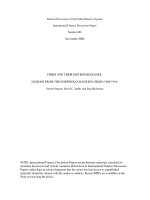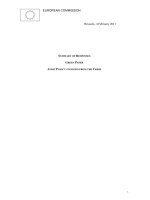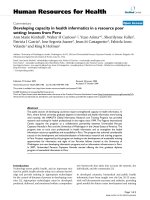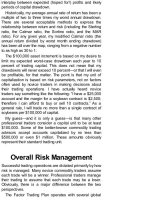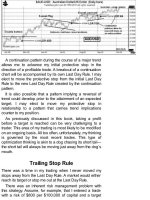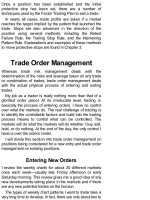Diary of a Professional Commodity Trader: Lessons from 21 Weeks of Real Trading_8 ppt
Bạn đang xem bản rút gọn của tài liệu. Xem và tải ngay bản đầy đủ của tài liệu tại đây (813.36 KB, 24 trang )
Being wrong on 91 percent of trades over a series of 27
trading events reaches the outer extreme of a bell curve
distribution. The standard deviation of this occurrence is
quite extraordinary. But it is explainable. The reason is that
the distribution of profitable and unprofitable commodity
and forex trades in a data set is not random in the way coin
tosses or dice rolls are random. Dice and coins do not
have emotions. Traders do!
My recent losing streak included some self-defeating
trading practices, which skewed the statistical probability of
randomized results. Getting spooked by markets can lead
to defensive trading practices that can prolong a trading
drawdown. So, how exactly does this work?
The hardest trades to emotionally execute for a
discretionary trader—trades for which every cell in a
trader’s body screams to avoid—are often the best trades.
In contrast, trades that are emotionally easy to execute are
often trades consistent with the conventional wisdom of the
marketplace. Conventional wisdom is usually wrong. During
a losing streak, a discretionary trader (as opposed to a
systematic trader) can revert, at least subconsciously, to
those trades that seem safe. Nearly every losing trade
during the recent string developed an immediate profit.
From time to time over the years, I have toyed with the idea
of grabbing a quick $500 to $1,000 per contract profit and
walking away from trades.
The analysis of my trading in October and November (not
shown in this book) revealed too many trading events. I had
become too short term in my market analysis and was
overreaching for trades that I should not have taken.
Excessive market activity on my part is normally linked to
three types of trading events:
1. Too many major pattern anticipatory signals in
an attempt to pre-position for a major breakout
that may never occur. Weekly chart patterns can
take a long time to come to fruition. I tend to
exercise an itchy trigger finger to get involved
when I see a weekly pattern developing.
2. Too many minor pattern signals—accepting
patterns of lesser quality. The question I should
always ask when looking at a minor pattern is: “Is
the daily pattern I am considering one of the best
two or three minor daily chart patterns in this
market in the past year?” If the answer is no, then I
should skip the trade. As a reminder, a minor
signal in my approach is a chart configuration
visible only on the daily graph without confirmation
of any sort from weekly chart developments. As a
general rule, a minor signal should be a minimum
of four to eight weeks in duration for a
continuation chart pattern and eight to 10 weeks
in duration for a reversal chart pattern.
3. Lesser standards on major pattern pyramid
signals within an ongoing major trend. I become
too eager to pyramid a profitable trade.
These three types of trading events can synergistically
lead to a temporary lack of confidence in my trading plan.
My attitude coming into December was that I needed to
be choosier about the patterns I would trade. Instead of
identifying 18 to 20 or so trades monthly, I needed to
reduce the number of new trading events to around 13 to
15.
There is one other consideration I was taking into
account. December is often a tough month for trading.
Large traders are reluctant to press their advantage on
positions as they face the holiday period. Volume begins to
dry up in mid-December. Holiday markets are notorious for
running stops on both sides of the market in thin trading
conditions. This is an important fact because I normally
enter and exit trades using stop orders.
This was the backdrop for the beginning of this book. I
was thinking to myself: “Oh great, I am starting the trading
diary right in the middle of my worst trading spell in quite
some time. And I am starting the diary in a month that has
given me fits over the years. Wonderful!”
Trading Record
During December, I entered 13 new trading events in 12
different markets. Two trades were carried as open
positions into January.
EUR/USD: The First Trade of the Diary
Period
Signal Type: Major Completion Signal
Throughout November and December I had watched the
euro/U.S. dollar (EUR/USD) with an interest toward the
short side. In fact, I had been whipped around in two
attempts to get short, one in early November and then
again in mid-November. Figure 8.1 shows that the market
had developed a trend line from the March 2009 low.
Normally, I do not trade trend-line violations. Trend lines fall
into a category of chart development I called diagonal
patterns. Yet, the more a market tests a trend line, the more
valid—and tradable—an eventual violation becomes,
especially if a recognizable pattern occurs prior to the
trend-line violation.
FIGURE 8.1 A Major Trend Line with False Breakouts in
EUR/USD.
Finally, a tradable top began to form. The advance on
November 25 and 26 into new highs quickly failed and had
the earmarks of a bull trap. The market broke hard on
November 27 and then retested the bear-trap highs. Now I
had four chart developments that supported a trade, as
seen in Figure 8.2:
1. A bull-trap.
2. The potential for a decisive penetration of the
dominant trend line.
3. A trading channel from July to provide a price
target. A market completing a channel can be
reasonably expected to move the width of the
channel in the opposite direction.
4. A secondary and lower channel from the
November low.
FIGURE 8.2 A Bear Market Begins in EUR/USD.
The major signal breakout came on December 7 with the
penetration of the November 27 low. This marked the first
trade made for the diary. The high of December 7 became
the Last Day Rule, but I chose to risk the trade to above the
December 4 high. My position was short 35,000 EUR/USD
per trading unit of $100,000 for a risk of about 1 percent of
assets. I could have taken twice the leverage if I had
chosen to use the actual Last Day Rule stop from
December 7.
The target was reached at 1.4446 on December 17.
Looking Back
In hindsight, I realize that this was just the first leg down in a
massive bear trend. I leave money on the table by taking profits
at targets. I am not out to pick tops and bottoms. In a sense, I
play my game between the 30-yard lines, not from goal line to
goal line.
GBP/USD: An H&S Top Stutters, Then Is
Completed
Signal Types: Two Minor Reversal Signals
By late November, I was considering the possibility that
the GBP/USD was forming a massive double top dating
back to mid-May 2009. I often refer to a double top as an M
top. The October low was the midpoint low. There was a
real potential for a Best Dressed List trade in the GBP. The
decline on December 9 completed a seven-week H&S top
pattern. I thought the pattern could launch the move to
complete the double top.
I shorted 50,000 GBP/USD per trading unit on
December 9, using that day’s high as the Last Day Rule.
Unfortunately, this protective stop was hit on December 16
near the high of the day (see Figure 8.3).
FIGURE 8.3 A Potential Double Top in GBP/USD.
The December 16 high proved to be the high of the rally.
The market immediately turned lower without me. Such is
life! It happens! Sometimes the market gives me another
opportunity to get back in; sometimes it doesn’t. In this
case, it did, and there is a lesson in it.
I know just enough about candlestick charts to be
dangerous. While I believe knowledge of weekly
candlesticks could help my trading, I am a high/low/close
bar chartist and have not taken the time to adequately delve
into the study of candlestick patterns.
There is one candlestick pattern I do follow, the hikkake,
thanks to a good friend and fellow chart trader, Dan
Chesler (an independent market strategist based in south
Florida; Chesler Analytics, www.chesler.us). Dan alerts me
to hikkake patterns in markets he knows I am trading. I
have no interest in a hikkake in any market I am not trading
or looking to trade.
The hikkake is a failed inside-bar pattern. The inside bar
is a candlestick formation that occurs when a day’s candle
range is inside the range of the previous day. In the case of
a hikkake sell signal, the inside day is followed by one to
two days of advances above the high of the inside day,
followed by a decline back below the low of the inside day.
See Figures 8.4 and 8.5 for examples of the bear and bull
hikkake patterns.
FIGURE 8.4 A Bear Hikkake Pattern.
FIGURE 8.5 A Bull Hikkake Pattern.
I am most interested when a hikkake occurs consistent
with my overall viewpoint and trading strategy in a particular
market. So, as I was getting stopped out of GBP on
December 16, I knew that a hikkake sell signal was
possible.
The decline on December 17 sprung the hikkake and
recompleted the H&S pattern, confirming each other. I
reentered the short side of the market (40,000 GBP per
trading unit), using the December 17 high as the new Last
Day Rule (see Figure 8.6).
FIGURE 8.6 A Bear Hikkake in GBP/USD Confirms the
H&S Top.
This stop-out and reentry brings up an interesting point.
Was it painful to resell the market 160 points lower than
where I covered shorts just one trading day earlier? In some
ways, the answer is “yes”; in other ways; the answer is
“no”—-“yes” in that it is never fun to lose a 160-point
opportunity profit in a market, “no” in that the Last Day Rule
has been my most dependable chart-based money
management technique over the years.
In hindsight, we can see that the hikkake did its thing. But
what if the market had not completed the hikkake, but
instead traded strongly higher? I would have felt like a fool if
I had overridden the Last Day Rule and yielded instead to
the possibility of a hikkake. Remember, the hikkake is not
foolproof. A study of any chart can yield multiple examples
of hikkake patterns that failed.
There is another dimension to this discussion. I viewed
the two trades in GBP/USD as separate trades, each
subject to its own rules and guidelines, yet part of a
continuous campaign to be short GBP/USD. From the
standpoint of my trading rules and guidelines, it was
irrelevant that the two trades were only a day apart.
The target of the second GBP trade was 1.5668. I
covered the short position on December 30, without a good
reason other than emotional nervousness (see Figure 8.7).
FIGURE 8.7 Taking a Small Profit in the GBP/USD.
In the end, my Trailing Stop Rule would have been
triggered on December 31, the Last Day Rule on January
14. It is an exception when I end up for the better by
overruling my trading guidelines and rules as happened
with this trade.
Trading Spot Forex Markets
I started out my career trading foreign currency markets
through futures contracts at the International Monetary Market
(IMM; part of the Chicago Mercantile Exchange). By the mid-
1980s, I began trading the spot interbank or dealer market
rather than futures contracts. I prefer the spot market for many
of the reasons identified in the table on the pros and cons of
each trading vehicle shown below. Though it is not within the
scope of this book to provide educational background on
currency trading, there are pros and cons to both markets (see
following list). Understanding them can shed light on the
trades described in this chapter.
The IMM quotes and trades currency pairs in a consistent
manner. All the major pairs at the IMM are expressed as the
price of the foreign currency in U.S. dollars. For example, at the
present time the pound is at $1.5985, the Swiss franc at
$0.9681, the yen at $0.010906 (slightly more than a penny), the
euro at $1.4356, and the Canadian dollar at $0.9625. In each
case, the symbol would be expressed as the foreign currency
unit divided by USD—GBP/USD, EUR/USD, CHF (Swiss)/USD,
CAD/USD, JPY/USD.
Quoting and trading currency pairs in the spot market can be
more complicated. In some cases, the pairs are traded similar
to the IMM, such as the GBP/USD and EUR/USD. However, in
other cases, the spot market trades the inverse (or reciprocal)
expression of the IMM price.
For example, in the spot market, the Canadian dollar is
expressed as the number of Canadian dollars per USD, or
USD/CAD. USD/CAD is the reciprocal of CAD/USD. Saying that
the CAD is worth $0.9625 (symbol is CAD/USD) is the same
thing as saying there are 1.0390 CADs per USD (symbol is
USD/CAD).
Table 8.1 Dealer Spot vs. IMM Futures
Item Dealer/Interbank Spot IMM Futures
Variety of
forex pairs
Advantage spot; major and
minor currency units in all
combinations
Only major
currency units,
mostly in
combination with
the USD
Funds
protected
Only by faith and credit of
individual dealer
By the IMM’s
clearing firm
Quotes and
trading
Each dealer and trading
platform can have slightly
different bids and offers
Standardized, a
single market
Size of
trading units
Flexible Standardized
Volume,
liquidity,
hours of
trading
Advantage spot
Regulatory
oversight
Commodity Futures Trading
Commission (CFTC)/National
Futures Association (NFA) has
become involved
NFA/CFTC
Margin
requirements
(or leverage)
Approximately equivalent
Approximately
equivalent
Trade
settlement
Several days for interest and roll
charges to catch up to trade
Same day
The formula for conversion from USD/CAD to CAD/USD and
back is simple (1 divided by 0.9625 equals 1.0390; or 1 divided
by 1.0390 equals 0.9625). As the price of USD/CAD goes up,
the price of CAD/USD goes down by the reciprocal value. If I
thought the USD was going to gain in value on the CAD, I could
either go long the spot USD/CAD or go short CAD/USD at the
IMM.
Futures traders interested in trading the spot forex market
should be aware of one important thing. Not all spot forex
dealers and brokers are equal. There is one huge difference,
and futures traders know the difference by the words skid and
slippage. Skid occurs when a stop order is filled at a worse
price.
There are some forex brokers who nearly always fill stops on
the nose with little or no slippage. Huge skid can occur with
other forex brokers. I believe that the brokers and dealers who
impose skid on traders are ripping them off. The forex markets
are the most liquid markets in the world. There should never
be much skid. Skid occurs as a profit center for the forex
brokers in question. Forex dealers who rip off their speculative
clients know who they are. I know who you are. I am not
naming names, although I could. You are abusing small
speculators. Shame on you! Stop it! You are already imposing
huge bid/offer spreads on speculative clients—learn to be
satisfied earning the bid/offer spread!
March Sugar: A Four-Month Channel Is
Resolved
Signal Type: Major Breakout Signal
Next up was my best trade of the month, and one of my
better trades in all of 2009—in fact, a member of 2009’s
Best Dressed List.
I had been frustrated from August through early
December, expecting another thrust higher in sugar based
on the monthly chart. In fact, I experienced four losing trades
during this time period as I attempted to get pre-positioned
for a run to the stars.
The market finally completed a three-month-plus major
signal breakout of a continuation channel on December 11.
If you look at Figure 8.8 carefully, you will see that the final
four weeks of this channel developed an H&S bottom
pattern.
FIGURE 8.8 Sugar Breaks Out of a Four-Month Channel
and One-Month H&S Bottom.
As usual with valid breakouts, the Last Day Rule was
never threatened. I took a position of one contract per
trading unit of $100,000 for a risk of about eight-tenths of 1
percent (0.8 percent). I should have had more guts to
assume more leverage—and I knew it at the time.
I got bumped out of half my position (one-half contract
per trading unit) on December 22 based on the Trailing
Stop Rule, and covered the remainder of the position on
December 28 at the pattern target of 2736.
Looking Back
I took a couple more shots at this market during January 2010
before the market eventually topped. In 2009, sugar was my
single most profitable market. It is not unusual for a market that
causes me fits for a year or two to become highly profitable at
some point, just as it not unusual for a market that is highly
profitable one year to become a source of trading losses the
next. It is important for chart traders to remember that we do not
trade markets—we trade chart patterns. The labeling on the
chart is unimportant.
March Cotton: A Pattern to Trade Too
Small to Trade
Signal Type: Miscellaneous Trade
This next trade was a great example of allowing my
emotions to dictate decisions when I am missing a big
trend. Cotton was in a strong trend, and every day I saw it
going higher.
I used the excuse of a three-week pennant to go long on
December 14. I moved my stop in relationship to the retest
on December 18 and was stopped out on December 22
with the Retest Failure Rule (see Figure 8.9).
FIGURE 8.9 An Emotional Trade in Cotton.
The results are seldom good when I find an excuse to get
aboard a market I have missed from an earlier trading
signal.
March Soybean Oil: A Case of Getting
Whipped in Both Directions
Signal Types: Major Breakout Signal and
Instinct Trade
The gap up on November 16 completed a triangle
bottom in March Soybean Oil. I should have gone long on
November 16, or on November 24 or November 27 when
the triangle was retested. I just did not step up to the plate.
Had the market gone straight up, I would have kicked
myself for missing a great trade. But, finally, I went long at
the December 15 retest of this triangle, believing that the
market would not close the November 16 gap (see Figure
8.10).
FIGURE 8.10 A Breakout of a Symmetrical Triangle in
Soybean Oil Lacks Follow-Through.
As shown in Figure 8.11, on December 17 I was stopped
out when the market completed a four-week H&S top
pattern. I also went short. This short was an instinct trade. A
four-week pattern is not enough of a chart structure for me
to trade. I exited the short position when the market closed
back above the neckline on December 28. Zero for two in
soybean oil trades in a matter of two weeks.
FIGURE 8.11 A Small H&S Top Reverses the Bottom in
Soybean Oil.
My leverage on both trades was seven-tenths of a
contract per trading unit.
AUD/USD: Selling the Breakout and
Then Selling the Retest of an H&S Top
Signal Type: Two Major Breakout Signals
The 10-week H&S top in the AUD/USD was a possible
candidate for the Best Dressed List. The only problem I had
with the trade was that the right shoulder low consisted of a
one-day spike. Yet I go by the general rule that “function
should follow form.”
I shorted the market on December 16, actually leading
the breakout by a day. My leverage was 45,000 AUD per
trading unit. I exited the market on December 28 for a small
profit based on the Trailing Stop Rule. See Figure 8.12.
FIGURE 8.12 A Failed H&S Top in AUD/USD.
Then I reestablished my short at the retest on December
31, only to be stopped out on January 4 using the original
Last Day Rule.
March DAX: Riding a Winner into a
Loser
Signal Type: Major Breakout Signal
On December 16 the March Deutscher Aktien Index
(DAX) completed a textbook ascending triangle. The
market faltered for the next two days but did not violate the
Last Day Rule at 5810. Then, on December 21, it
appeared as if the DAX would take a run for the roses. My
leverage was one-half contract per trading unit.
As shown in Figure 8.13, the breakout proved to be an
end-around. I was stopped out at the Last Day Rule on
January 21. The Trailing Stop Rule would have let me out of
the trade on January 15, but I got stubborn.
the trade on January 15, but I got stubborn.
FIGURE 8.13 An Ascending Triangle in DAX with an End-
Around Move.
A trade like the DAX creates agony and makes me
question my trading plan and decision making. The DAX is
a big contract; I had an open trade profit in the trade of
nearly $2,800 per contract. Then the market did a slow and
agonizing turn. I gave it all back, and more. Watching a
market day by day do a round trip is not fun. I call these
popcorn trades.
March Soybeans: Taking a Loss on a
Trade, but Not Staying with the Idea
Signal Type: Miscellaneous Trade
Like the trade in soybean oil cited earlier, a four-week
reversal H&S top is not a pitch I should swing at. I went
short on December 17, the day before the actual breakout.
The market declined for three days, then reversed. I got
stopped out on December 28 using the Last Day Rule (see
Figure 8.14).
FIGURE 8.14 A Small H&S Top in Soybeans Turns into a
Larger H&S Formation.
I want to use the soybean chart to make one more point
about the H&S formation. It would have been tempting to
have redrawn a larger H&S with the left shoulder in October
and the right shoulder in early January. And, in fact, this
pattern would have produced a profit without ever
challenging the breakout entry. Yet I did not call this larger
pattern an H&S top for two reasons, even though a
profitable surge was the outcome.
First, an H&S reversal needs to reverse something. This
larger pattern was just part of a broad trading range.
Second, I prefer to have a more horizontal neckline and
more symmetry between the height and duration of the left
and right shoulders. Nevertheless, I counted this sharp
decline as a missed trade.
March Mini Nasdaq: An Ascending
Triangle Produces a Profitable Trade
Signal Type: Minor Continuation Signal
The advance on December 21 completed a three-week-
plus continuation ascending triangle, putting me long one
mini contract per trading unit. It was also possible to
interpret this pattern as a six-week continuation inverted
H&S pattern, but the left shoulder was poorly formed (see
Figure 8.15).
FIGURE 8.15 An Ascending Triangle in the Mini Nasdaq.
I chose the first interpretation because it had the lesser
target. The uptrend in the stock market was long overdue a
correction at the time, in my opinion, so I did not want to
use the more aggressive objective. The market reached its
lower target on December 28.
USD/CAD: A One-Day-Out-of-Line
Movement
Signal Type: Minor Reversal Signal
I shorted the market on December 29, which proved to
be a one-day-out-of-line movement. I was stopped out at
the Last Day Rule on December 30 (see Figure 8.16).
FIGURE 8.16 A Descending Triangle in USD/CAD Initially
Stutters, Then Fails.
It is not a very good sign when a market closes against
me the same day I put it on. My net bottom line over the
years would have improved if I had exited all trades that
closed against me.
Summary
There are losing trades, losing days, losing weeks, losing
months, losing quarters, and, unfortunately, there can even
be losing years. I have experience with all of these.
December was a tough month when I consider open trade
profits from the end of November that disappeared before
being closed in December. But this book is covering the
period from early December forward, so I will limit my
specific comments to trades from this period.
Compared to the benchmarks of the Factor Trading
Plan, the profile of trades opened in December is shown in
Table 8.2.
TABLE 8.2 December 2009 Trading Signals by Category
Signal Category
December Entries (number and %
of total)
Historic
Benchmark
Major patterns
Completions 6 (46%) 4 (19%)
Anticipatory 0 2.5 (13%)
Pyramid 0 2.5 (13%)
Minor patterns 4 (31%) 5 (26%)
Instinct trades 1 (8%) 3 (17%)
Miscellaneous
trades
2 (15%) 2.5 (13%)
Total 13 (100%) 19.5 (100%)
I do not get too concerned when the profile of trades for a
single month is askew from the historical benchmark
norms. I am more interested in quarterly and annual trends
away from the norm.
Of the 13 trades that were opened during December, 11
were closed by the end of the year: five as profits and six
as losses. This ratio exceeds the historical benchmark of
only 30 to 35 percent of trades being profitable.
The fourth quarter was a tough trading environment for
me. Many trades started out well, only to reverse direction
and result in losses. Other times, I was too quick to
advance a protective stop, only to be stopped out and have
a market then go in its expected direction. It was not a
great quarter for commodity trading advisors (CTAs) in
general. Figure 8.17 is a graph showing the widely followed
Lyxor Short-Term CTA Index.
FIGURE 8.17 Lyxor Short-Term CTA Index.
Source: Lyxor Asset Management
(www.lyxorhedgeindices.com/index.php).
The index was down (6.2 percent) in the fourth quarter.
But from my point of view, misery does not like company. I
must compare my performance to my own approach and
not to others. It is easy after the fact to identify
modifications to one’s trading plan that would have done
well in retrospect.
When analyzing a concluded trading period, I draw a
distinction between three aspects of the trading equation:
1. What type of markets did we have (trending or
choppy)?
2. How well did my trading plan and its rules synch
with what the markets offered?
3. How well did I execute the plan?
The type of markets experienced is an uncontrollable
variable. There is nothing I can do to change market
behavior. However, I do have some general control over my
trading plan, although it is impossible to alter trading rules
to optimize the results of any given trade or series of
trades. I have even greater control over the degree to which
I correctly execute my trading plan—or, stated in the
negative, the degree to which I violate my own rules.
It is entirely conceivable that I could be more pleased
with my trading during an unprofitable period in which I
faithfully implement a predetermined game plan than with
my trading during a profitable period in which I mismanage
some trades and do not fully exploit other signals.
Trades established in December, when closed,
produced a profit of 1.5 percent. Some of these profits
were closed in January. On a Value Added Monthly Index
(VAMI) marked-to-the market basis, my trading
performance for December was up .04 percent.
A complete trade-by-trade record for this book can be
found in Appendix A.
Chapter 9
Month Two
January 2010
Iam really glad the fourth quarter of 2009 is now history. I
can start a new year. I traded only proprietary capital during
the first nine months of 2009. My proprietary account was
profitable in 2009 due primarily to trades in Sugar and
Gold. I discontinued implementing the full Factor Trading
Plan for proprietary capital to make ready for trading a
commodity pool account, of which I would be a major
stakeholder. The pool took a long time to get going but was
finally functioning in October 2009, just in time for a
drawdown. The fourth quarter served up an ample portion
of humble pie. I have never developed a taste for humble
pie and seriously doubt I ever will. The taste is bitter.
Drawdowns are a way of life for a trader. Periods of
capital drawdown bring about tremendous introspection.
When trading is going well, it is easy to think trading will
never get bad again. When trading goes sour, it is difficult
to remember the profitable times.
I have experienced significant drawdowns during each of
the 17 years I traded proprietary funds as my full-time
occupation. (I quit trading for a few years to pursue some
non-profit endeavors). Table 9.1 is a rank order of my worst
drawdowns through the years.
TABLE 9.1 Factor LLC’s Worst Drawdowns
Peak-to-Valley Duration in
Drawdown, Month Months from
Period
Ending
*
Peak to Valley
Dec. 1981–Mar. 1982 (33.7%) 4
Apr. 1986–July 1986 (32.2%) 4
Sept. 1987–Apr. 1988 (27.2%) 8
July 1982 (26.3%) 1
Mar. 1985–June 1985 (21.1%) 4
Mar. 2008–May 2008 (19.7%) 3
Jan. 2007–Mar. 2007 (19.5%) 3
Dec. 1983–Feb. 1984 (18.2%) 3
July 1988–Dec. 1988 (15.4%) 6
July. 1984–Oct. 1984 (12.9%) 2
Aug. 1985 (11.8%) 1
Apr. 1989 (11.6%) 1
*
The data above represent actual proprietary trading performance. The
leverage currently being employed by the Factor Trading Plan is one-third
of that used prior to October 2009. The Author’s Note at the end of this
book contains the disclosure statements related to the past performance
of Factor LLC.
My point is that trading is not an easy endeavor or
everyone would be doing it. Trading is tough work. All of the
drawdowns listed were from years when I was much more
risk tolerant and traded significantly greater leverage. The
current Factor Trading Plan is a carbon copy of previous
years in terms of entry signals and exit strategies, but
leverage that has been reduced by two-thirds. Cutting
leverage by this magnitude reduces the risk of large
drawdowns, but it also minimizes upside potential. I have
lived through drawdowns before, and I will live through them
again in the future.
Identifying Trading
Opportunities
I like to start the new calendar year by identifying trades I
believe offer tremendous opportunity for profits in the
upcoming months. For 2010, I chose six: short British
pound/U.S. dollar (GBP/USD), short Standard & Poor’s
(S&Ps), short T-bonds, long gold, and long sugar. We may
see how right I am by the end of the book.
GBP/USD: Still Building a Major Double
